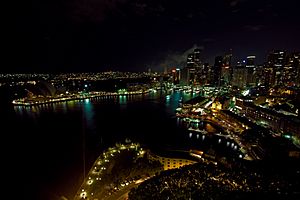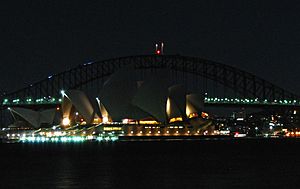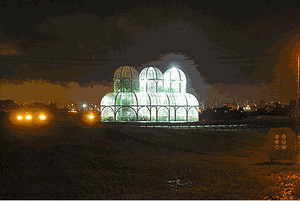Earth Hour facts for kids
Quick facts for kids Earth Hour |
|
|---|---|
 |
|
| Observed by | World Wildlife Fund for Nature (WWF) |
| Type | International, Movement, World Wildlife Fund (WWF) |
| Significance | Climate change and to save Earth |
| Celebrations | Mass activations to encourage the public to give an hour for the planet; Switching off national and international monuments and landmarks |
| Begins | 8:30 pm |
| Ends | 9:30 pm |
| Date | Last or penultimate Saturday of March |
| 2024 date | March 23 |
| 2025 date | March 22 |
| 2026 date | March 28 |
| 2027 date | March 20 |
| Frequency | Annual |
| Related to | Earth Day |
Earth Hour is a big event organized by the World Wildlife Fund (WWF). It happens every year. People, groups, and businesses turn off their lights for one hour, from 8:30 PM to 9:30 PM. This usually happens on the last Saturday of March. It's a way to show we care about our planet. The event started in Sydney, Australia, in 2007. Sometimes, if a holiday called Holy Saturday is on the same day, Earth Hour happens a week earlier.
Contents
- The Story of Earth Hour
- How Earth Hour Began (2004-2007)
- Earth Hour Grows Globally (2008)
- "Vote Earth" Campaign (2009)
- Earth Hour Continues to Grow (2010)
- "Beyond the Hour" (2011)
- Earth Hour Goes Global (2012)
- Earth Hour for Forests (2013)
- Earth Hour Blue (2014)
- Focus on Climate Change (2015)
- 10th Anniversary (2016)
- Recent Earth Hour Events
- Why Earth Hour Matters
- See also
The Story of Earth Hour
How Earth Hour Began (2004-2007)
In 2004, the WWF in Australia learned about new scientific findings. They met with an advertising company to think of ways to get Australians to care about climate change. By 2006, they came up with the idea of a big "lights off" event.
WWF Australia shared their idea with a media company and the mayor of Sydney, Clover Moore. Everyone agreed to support the event. The first Earth Hour happened on March 31, 2007, in Sydney, Australia. Lights went off at 7:30 PM local time.
Later in 2007, San Francisco in the USA had its own "Lights Out" event. It was inspired by Sydney's Earth Hour. After their success, they decided to join the bigger Earth Hour event planned for 2008.
Earth Hour Grows Globally (2008)
Earth Hour became a worldwide event on March 29, 2008. It took place from 8 PM to 9 PM local time. This was one year after the first event. Thirty-five countries and over 400 cities officially joined in. Famous buildings and landmarks around the world turned off their lights. Even some websites, like Google, went "dark" for the day.
A survey showed that 36 million Americans took part in Earth Hour 2008. This was about 16% of all adults in the United States. The survey also found that more people became interested in environmental issues after the event.
Some cities changed their Earth Hour time. Tel Aviv in Israel held their event on a Thursday to avoid a religious day. Dublin in Ireland moved their time to 9 PM to 10 PM because of their location in the north.
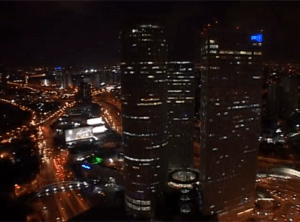

Many cities reported saving electricity during Earth Hour. Bangkok, Thailand, saved 73.34 megawatts of electricity. This is like saving 41.6 tonnes of carbon dioxide. In the Philippines, power use dropped by about 78.63 megawatts in Metro Manila. The whole Luzon island saved up to 102.2 megawatts.
Ontario, Canada, used about 900 megawatt-hours less electricity. Toronto saw an 8.7% drop in power use. Ireland reduced its electricity use by about 1.5%. In Dubai, electricity savings were 100 megawatt-hours. This was a 2.4% drop in demand.
The city of Christchurch, New Zealand, had the best result. Their electricity demand dropped by 13%. Melbourne, Australia, reduced demand by 10.1%. Sydney, where it all began, cut electricity use by 8.4%.
However, Calgary, Canada, saw its power use go up by 3.6%. This was because the weather was much colder than the week before. In later years, Calgary's power use changed very little during Earth Hour.
"Vote Earth" Campaign (2009)
Earth Hour 2009 happened on March 28, from 8:30 PM to 9:30 PM local time. The campaign was called "Vote Earth." It aimed to get one billion "votes" for Earth. This was important because of a big climate change meeting happening that year. WWF said that 88 countries and 4,159 cities took part. This was ten times more cities than in 2008.
For the first time, the United Nations Headquarters in New York City joined in. In Egypt, the lights on the Sphinx and the Great Pyramids of Giza went out. The Philippines had 647 cities and towns participate. Over 10 million Filipinos joined the lights-off event.
Many places reported saving electricity. The Canadian province of Ontario (not including Toronto) saw a 6% drop in electricity use. Toronto had a 15.1% decrease. The CN Tower also went dark. The Philippines saved 611 MWh of electricity. This was like turning off a dozen coal power plants for an hour.
In Sweden, electricity use dropped by 2.1% during Earth Hour. This is like the power used by half a million homes. Vietnam's electricity demand fell by 140 MWh.
Earth Hour Continues to Grow (2010)
Earth Hour 2010 was on March 27, from 8:30 PM to 9:30 PM local time. In Israel, it was held on April 22. A total of 126 countries participated.
In the United States, about 90 million Americans took part. Lights went off at famous places like Mount Rushmore, the Las Vegas Strip, the Empire State Building, and Niagara Falls. Some cities used Earth Hour to make lasting changes. In Chicago, building owners created rules to reduce light pollution. Mount Rushmore started turning off its lights earlier each night.
In Vietnam, electricity demand dropped by 500,000 kWh. This was three times more than in 2009. In the Philippines, 1,067 towns and cities joined. Over 15 million Filipinos participated. About 4,000 cities worldwide took part. Famous landmarks like Big Ben, the Eiffel Tower, and the Forbidden City went dark.
"Beyond the Hour" (2011)
Earth Hour 2011 was the biggest yet. It became the largest volunteer action for the environment. The new idea was "Beyond the Hour." This encouraged people to do more than just turn off lights for 60 minutes. The Earth Hour logo changed to include a "60+" symbol. This symbol is still used today.
Earth Hour 2011 happened in 5,251 cities and towns across 135 countries. It reached about 1.8 billion people. In India, the event was on March 26, from 8:30 PM to 9:30 PM. A TV channel even stopped broadcasting during that hour.
In Azerbaijan, the Maiden Tower went dark. The Philippines had an early "Earth Hour" when power accidentally went out. After power came back, many buildings still turned off their lights. TV channels also stopped broadcasting.
Thirty cities in Vietnam took part. The country's electricity demand fell by 400,000 kWh. This saved about US$23,809. YouTube promoted Earth Hour by changing its logo. It also added a switch to turn the video background from white to black.
Some areas in Canada, like Alberta, had not always fully supported Earth Hour. In 2011, Edmonton's power use actually went up. While Calgary's power use went down, officials could not be sure if it was due to Earth Hour or normal changes.
Earth Hour Goes Global (2012)
In February 2012, the main office for Earth Hour moved from Sydney to Singapore. Earth Hour 2012 was on March 31, from 8:30 PM to 9:30 PM. It took place in over 7,000 cities and towns across 152 countries. This was the biggest growth year for the event since 2009. It was also the first time Earth Hour was celebrated in space! A Dutch astronaut tweeted about it from space.
Earth Hour for Forests (2013)
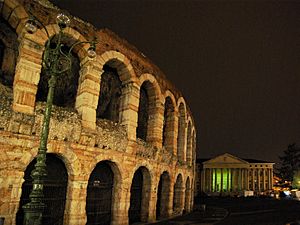
Earth Hour 2013 was on Saturday, March 23, from 8:30 PM to 9:30 PM. The date was chosen to avoid a holiday and to have a bigger impact.
Africa's Green Efforts
In 2013, the world's first Earth Hour Forest started in Uganda. This project aims to replant trees on 2,700 hectares of land. A bank in Uganda promised to help plant over 250,000 trees. In Madagascar, Earth Hour helped give 1,000 wood-saving stoves to people affected by a cyclone. The former President of Botswana promised to plant one million native trees over four years.
Europe's Forest Protection
WWF-Russia started a campaign in 2013 to get over 100,000 signatures. They wanted to change laws to protect forests. The petition got more than 127,000 signatures. This meant politicians had to discuss the new laws.
Earth Hour Blue (2014)
Earth Hour 2014 was on Saturday, March 29, from 8:30 PM to 9:30 PM. A new platform called "Earth Hour Blue" was launched. It allowed people to donate money or offer help for environmental projects. The idea was for people worldwide to work together to fund projects that help the planet.
The 2014 report showed many good results from Earth Hour. Over US$60,000 was raised for WWF projects. Campaigns helped protect Australia's Great Barrier Reef. A "Blue Sky App" was launched in China. Thousands of wood-saving stoves were given to communities in Madagascar.
Focus on Climate Change (2015)
Earth Hour 2015 took place on Saturday, March 28, from 8:30 PM to 9:30 PM. The main message was "Change Climate Change." This brought the event back to its original goal of getting people to act on global warming. Over 170 countries and 1,200 landmarks joined in. Nearly 40 UNESCO World Heritage Sites turned off their lights.
Earth Hour Blue continued to raise money for climate projects. These included giving solar lights in the Philippines and India. They also supported wildlife projects in Colombia, Uganda, and Indonesia.
On an island in the Philippines called Sibuyan, people did something different. They turned their lights ON during Earth Hour. This was to show that they use clean, renewable energy from a mini-hydro power plant.
10th Anniversary (2016)
Earth Hour 2016 was on Saturday, March 19, from 8:30 PM to 9:30 PM. The date was changed to avoid a holiday. This year marked the 10th anniversary of the campaign. Almost all countries in the world observed Earth Hour.
Recent Earth Hour Events
- 2017: Earth Hour happened on Saturday, March 25, from 8:30 PM to 9:30 PM.
- 2018: Earth Hour took place on March 24, from 8:30 PM to 9:30 PM. This was to avoid a holiday.
- 2019: Earth Hour was held on March 30, from 8:30 PM to 9:30 PM. A total of 188 countries participated. A special ambassador from Vietnam encouraged everyone to turn off lights to "Save Energy, Save Earth."
- 2020: Earth Hour took place on Saturday, March 28, from 8:30 PM to 9:30 PM. Because of the COVID-19 pandemic, it was mostly a digital event. Many famous people and leaders supported it online.
- 2021: Earth Hour took place on Saturday, March 27, from 8:30 PM to 9:30 PM.
- 2022: Earth Hour took place on Saturday, March 26, from 8:30 PM to 9:30 PM.
- 2023: Earth Hour took place on Saturday, March 25, from 8:30 PM to 9:30 PM. This year, it was called the "Biggest Hour for Earth." It focused more on community actions beyond just turning off lights. People pledged over 410,000 hours of planet-friendly activities.
- 2024: Earth Hour 2024 took place on Saturday, March 23, from 8:30 PM to 9:30 PM. This was to avoid a holiday. In the Philippines, people turned off their lights. The event focused on stopping plastic pollution. Many businesses, like Jollibee Foods Corporation, also joined in.
Why Earth Hour Matters
The Earth Hour organizers say that the event is not just about saving electricity for one hour. It's a way to show that people, businesses, and governments care about their impact on the environment. It encourages everyone to talk about and find real solutions to environmental problems. Taking part in Earth Hour shows a promise to make changes that last longer than just one hour.
A study in 2014 looked at 274 measurements of electricity use during Earth Hour. It found that the events reduced electricity use by about 4% on average. The study noted that the challenge is to turn this short-term saving into long-term actions. This includes changing habits and investing in greener solutions.
See also
 In Spanish: Hora del Planeta para niños
In Spanish: Hora del Planeta para niños


